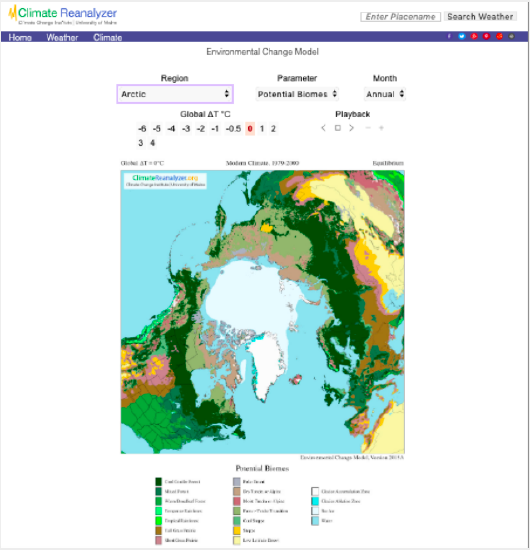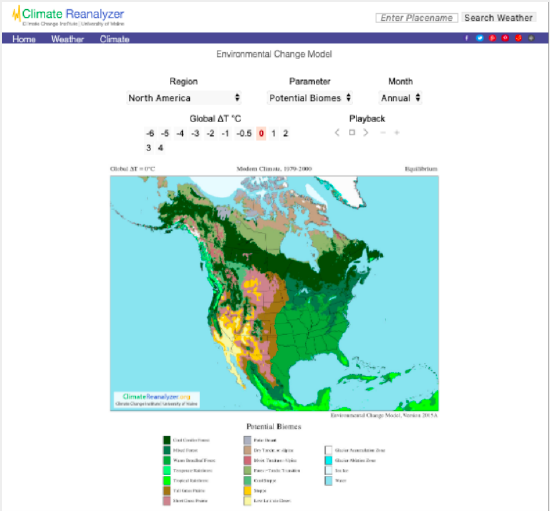19.2: Investigation
- Page ID
- 28647
Activity A – Biomes of North America
Launch the Environmental Change Model. See the first page of this activity for web address for the model. When you do this, you should see a screen that looks like Figure 19.2.1. Next select the region you in which you live, from the drop-down menu labeled “Region”. Then make sure that “Parameter” is set to Potential Biomes, “Month” is annual, and “Global ∆T°C” is set to 0. For instance, if you select North America you should see something that looks like Figure 19.2.2.


Biome Characteristics - Questions
- What biomes are present in the region you selected?
With the ECM set up to show the region you live in, use the biome map and the information panels below the map to address the following questions.
- What are the primary characteristics of each biome?
- Approximately where are these biomes?
- Where do you currently live and in what biome is this place?
Activity B – Impact of rising global temperature on biomes
Begin this activity by switching the parameter to temperature.
Current temperatures - Questions
- What is the present range of the annual temperature on land in °C for your region? To find this make sure that Global ∆T°C is 0 and Month is set to annual.
- Where on land is average annual temperature below freezing (T < 0°C)? Where is annual temperature above 20°C?
With Parameter still set to temperature slowly shift Global ∆T °C from 0 to 4°C noting what happens to the temperature map as you do so.
Changes in temperature and precipitation - Questions
- At Global ∆T = +4°C where on land is average annual temperature below freezing. Where is annual temperature above 20°C?
- As you move from ∆T = 0°C to 4°C what happens to the areas where annual land temperatures are below freezing and those areas where it above 20°C?
- Now switch Parameter to precipitation and reset ∆T to 0°C. Make sure that Month is still set to annual.
- What is the present range the precipitation on land in cm for the region you selected?
- Where on land is it the driest and where is it the wettest? What is the value for precipitation at each place?
- At Global ∆T = +4°C where on land is it the driest? Where is it the wettest?
- As you move from Global ∆T = 0°C to +4°C what happens to these wet and dry areas?
Finally switch Parameter to Potential Biomes and reset Global ∆T to 0°C. Make sure that Month is still set to annual.
Biome Changes - Questions
- What biomes appear in those areas where the average annual temperature is below 0°C?
- What biomes appear in those areas where annual temperature is above 20°C?
- What biomes appear where the land is the driest?
- What biomes appear where it is the wettest?
- As you move from Global ∆T = 0°C to +4°C what happens to the biomes you listed in questions 7 above through 3?
Activity C – Synthesis
Synthesis questions
- What general statement can you make about the impact of rising global temperature and the distribution of biomes?
- How does what you found out in questions 1 through 8 in activity B explain what you concluded in the previous question?
- What is the implication of what you concluded in questions 1 and 2 of Changes in temperature and precipitation – Questions in activity B on the extent of permafrost in upper Canada and Alaska?


